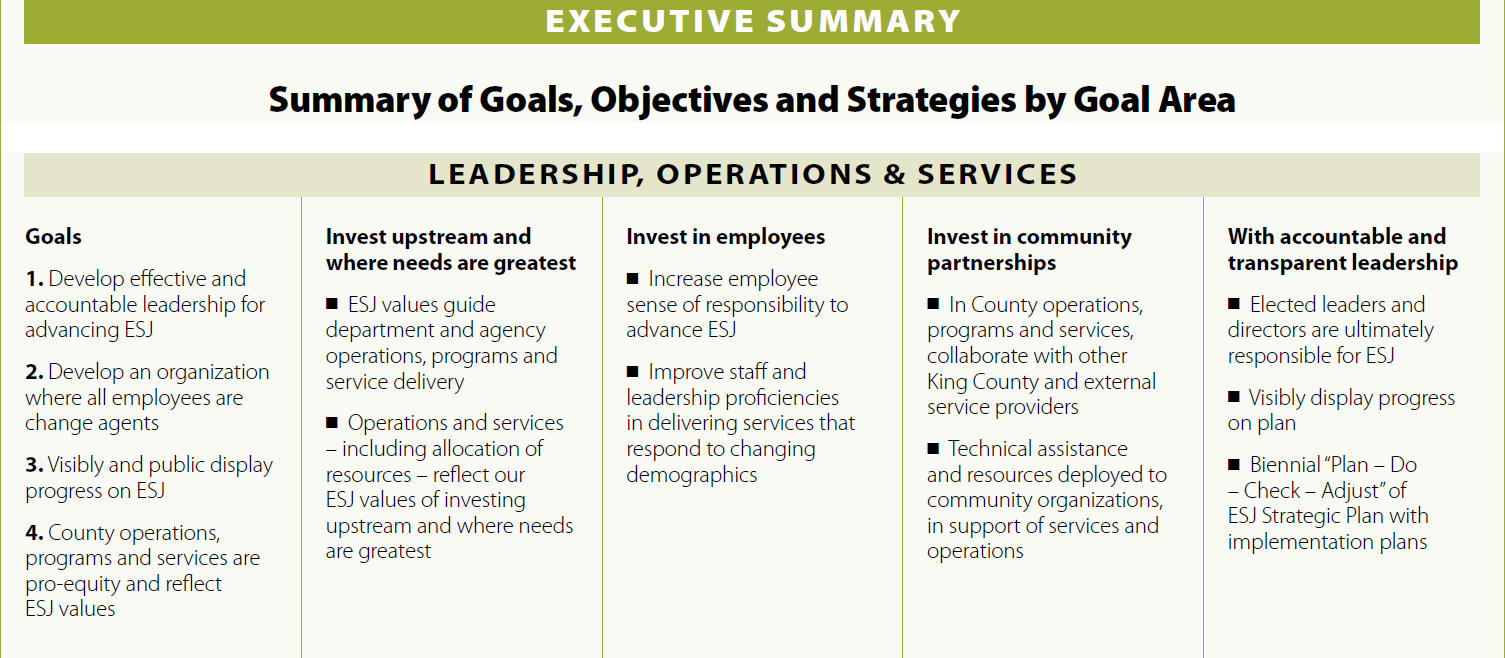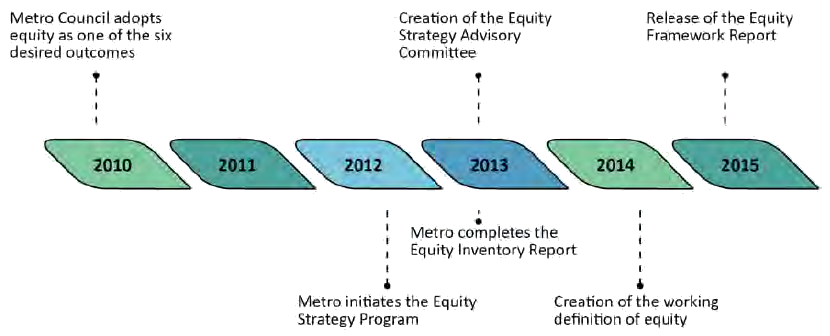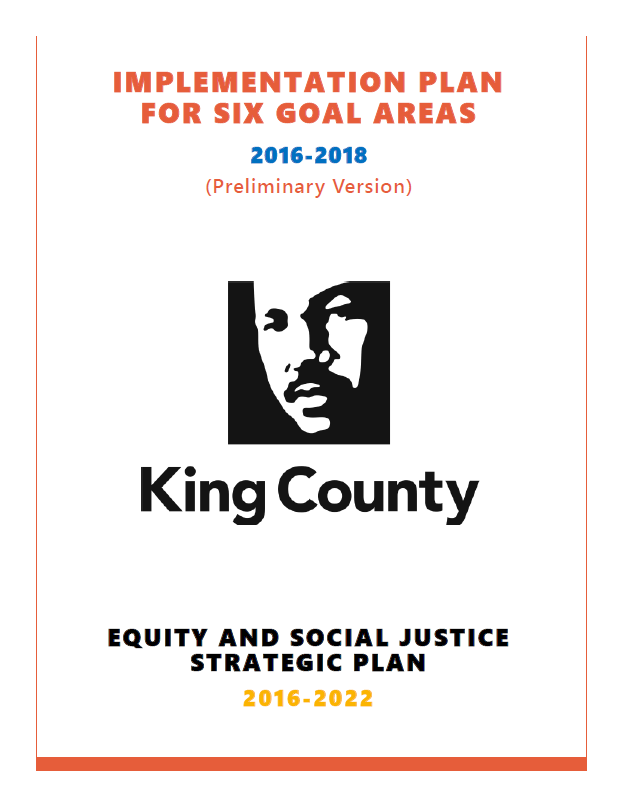Comparing municipal and regional equity strategic plans
PA 5251, Fall 2017
Group 6: Fun Fun Cheng, Kate Doyle, Ingrid Lyons, Jason Samuels, Nicole Tommerdahl
How to operate this presentation
Start
Instructions
- Press the F11 key to go full screen
- To advance to the next slide, press the spacebar
- ..or use the arrow keys to navigate
- To see the slide overview, press the Esc key
- Alt-click using the mouse pointer to zoom
Equity vs. Equality

King County
fair and equal access to opportunities, power and resources so that all people achieve their full potential and thrive. Equity is an ardent journey toward well-being as defined by those most negatively affected
Portland
Equity is when everyone, including members of diverse communities, has the opportunities necessary to satisfy their essential needs, advance their well-being and achieve their full potential
Minneapolis
equity means fair and just opportunities and outcomes for all people
Equity definitions
Approaches to Equity Planning:
A Historical Context
- Equity strategic planning concept rose to prominence in the Civil Rights Era
- Backdrop of the Economic Opportunity Act of 1964 and the Civil Rights Acts of 1964 and 1968
-
The moral value of equity resonated as a valid reason for achieving equity.
Norman Krumholz, Cleveland’s Planning Director, 1969-1979
-
Explicitly addressed poverty and racial segregation
-
Called on planners to be socially active by representing marginalized voices and promoting equity in planning processes
-
Equity achieved through the principle of redistribution by prioritizing the needs of those who are “less favored by present condition” within a context of limited urban development resources
The moral value of equity advocated by Krumholz can still be found in the language of equity strategic plans
King County
equity is fundamental to the society we seek to build
Portland
committed to ensuring all people in the region have the opportunity to thrive in all aspects of social well-being
Minneapolis
is "targeting its resources to making a noticeable impact on disparities"
From moral value to economic value
-
Targeted strategies for reducing disparities, such as racially-based, became politically unfeasible
-
Those who worked towards equity weren’t necessarily able to move from equitable process to actual equitable outcomes.
-
Economic downturns
-
Recessions in 1970’s and 1980’s
-
The Great Recession of 2008 to 2009
-
- Committed to a strong free market, deregulation, privatization, and a minimalist state.
- Rejects social spending based on targeting and redistribution.
- Shifts the dynamic from moral value as the primary driver to “prosperity for all”
Neo-Liberalism
Neo-liberalism's influence on equity strategic plans
King County
inequities undermine our collective prosperity and threaten our ability to remain globally competitive
Portland
our current and future diversity will help develop and maintain sustainable economic growth
Minneapolis
Racial Equity Policy Work Group has made diversity and equity a business goal and included mission and vision statements to support this framing
Targeted Universalism
-
Created by john a. powell as a response to the dichotomy of moral value vs. economic value; democratic goals vs. free market capitalism
-
Combines the terms “Targeted” (for a specific population) and “Universalism” (for everyone)
-
“Targeted within universalism means identifying a problem, particularly one suffered by marginalized people, proposing a solution, and then broadening its scope to cover as many people as possible.”
- Based on the premise that problems faced by particular segments of American society are problems that can spill over into the lives of everyone.
Targeted universalism in equity strategic planning
King County
we must approach with targeted universalism - where we define goals for all, identify obstacles faced by specific groups, and build on assets to tailor strategies to address the barriers in those situations
Portland
by addressing the barriers experienced by people of color, we will effectively also identify solutions and remove barriers of other disadvantaged groups
Minneapolis
racial inequities are addressed and eliminated so all Minneapolis residents can participate and prosper
Context
Geographic context
King county |
Portland |
Minneapolis |
|---|---|---|
1.9 million residents |
1.6 million residents |
400 thousand residents |
2,037 square miles |
463 square miles |
54 square miles |
Demographic context

Context in common
All three areas are majority-white geographies with inequities embedded into their histories and systems
Internal context
External context
-
King County: Equity planning led by Office of Equity and Social Justice, with key support from the County Council
-
Portland: Metro council stakeholder committee called the Committee on Racial Equity (C.O.R.E.)
-
Minneapolis: Community activist pressure, especially in the wake of the death of Jamar Clark. Mayor Hodges won election in 2013 on an equity-focused platform, ran into some political resistance on the City Council
King County, Washington
Stakeholder Involvement
-
Included deep internal and external networking - developing relationships was a key outcome
-
Internal: More than 600 county employees were included in the development of King County's plan
-
External: Talks included 160 local organizations, ranging from community, education, philanthropy, labor, business, and other local governments
Resources allocated
The Office of Equity and Strategic Justice was created in 2015, facilitated creation of the King County Equity and Strategic Justice Plan
Goal areas will be implemented in two year cycles, aligned with the County's biennial budget process
The City of Seattle - 2017 Adopted and 2018 Endorsed Budget lists in detail ways that the city's budget supports Race and Social Justice initiatives
Plan structure
-
78 pages, divided into sections based on function of government
-
Each section contains an analysis of the current situation and strategic actions and goals to address current racial inequality
Vision
A King County where all people have equitable opportunities to thrive.
Goals
King County identifies 21 total goals, 3 to 4 for each of the six goal areas
-
Leadership, Operations & Services
-
Goal 1: Develop effective and accountable leadership for advancing ESJ
-
Goal 2: Develop an organization where all employees are change agents
-
Goal 3: Visibly and public display progress on ESJ
-
Goal 4: County operations, programs and services are pro-equity and reflect ESJ values
-
-
Plans, Policies & Budgets
-
Goal 1: Department and agency business plans include analyses of equity impacts
-
Goal 2: Policy guidance incorporates ESJ values and analysis
-
Goal 3: Budget decisions, rates, and allocations reflect the values and strategies of the ESJ strategic plan
-
-
Workplace & Workforce
-
Goal 1: Require an equitable, engaged and racially just workplace culture
-
Goal 2: Do systematic and equitable workforce development at all levels
-
Goal 3: Have and resource equitable employee development and access to opportunities
-
Goal 4: Build an organization of equitable access to and shared decision making
-
-
Community Partnerships
-
Goal 1: Systematically provide resource support to community-based organizations to leverage their expertise toward advancing ESJ outcomes
-
Goal 2: Create pro-equity contracting processes that are visible and accessible to contractors of varied size and capacity
-
Goal 3: Provide non-monetary support to community-based partners that build their internal capacities
-
-
Communication & Education
-
Goal 1: Focused on languages, update tools for public-facing communication and education to align with demographic changes
-
Goal 2: Develop tools for better engagement and access to services
-
Goal 3: Focused on technology access, improve use of internet, social media and mobile tools to engage and hear from under-served residents
-
Goal 4: Increase collaboration and language-related resources for employees to ensure inclusive engagement of residents in decision-making
-
-
Facility & System Improvements
-
Goal 1: Master and Line of Business (LoB) plans include clear objectives to advance ESJ
-
Goal 2: Capital development policy, budgets, portfolios and programs are pro-equity and contribute to improved community conditions
-
Goal 3: Responsibility for pro-equity progress is clearly defined at agency/department, division and section levels
-
Strategies
The King County plan identifies four key strategies. Within each of the six goal areas, 61 strategic objectives are identified by key strategy. Example:

Actions
-
The implementation plan details proposed actions for the immediate future, and identifies stakeholders who are accountable for implementing those actions
-
40 actions are identified within the next year
-
43 actions are identified for 2017 and 2018
Implementation Plan
-
Policy Areas are in three-year cycles, and Goal Areas are in two-year cycles. The latter is aligned with the County's budget process
-
SMART objectives are articulated to help measure progress
-
Build plan goals into department director contracts/agreements
-
Undertake a biennial "plan, do, check, adjust" process
Use of imagery: Theory of change


Use of imagery

Greater Portland
Stakeholder involvement
Participants involved included current and former council members, council staff from more than a dozen departments, nearly 20 multicultural community organizations, advisory committees made up of over two dozen community members
Consulted with four different organizations or individuals with specialties in equity strategy
External stakeholder engagement included citizen advisory committees, a public engagement committee, and a public engagement review network
Resources allocated
-
Metro adopted equity as one of the region's six desired outcomes in 2010
-
Operates alongside the Diversity Action Plan
-
In 2012, Metro initiated the Equity Strategy Program
-
Equity Inventory Report
-
Equity Strategy Advisory Committee
-
Creation of the Diversity, Equity and Inclusion Program
-
-
5-year process for goals

Plan structure
-
106 pages, including appendices
-
Goes in depth on five key goals and corresponding action plans
-
Defines key terms in sidebars to help clarify how Metro defines concepts
-
Also includes an implementation section, evaluation framework, & an analysis and decision support tool
Vision
Metro's plan does not explicitly identify a vision, states its mission as:
Metro is committed to working together with people, businesses, nonprofit organizations and public partners to create a Portland region where: all individuals and communities benefit from a strong economy; racial equity is recognized as the backbone of good governance; our public structures, institutions and processes address social and economic disparities for people of color; diversity is celebrated and all communities meaningfully participate in public decision-making.
Goals
Metro's plan identifies five goal areas and 15 total objectives
-
Goal A - Metro convenes and supports regional partners to advance racial equity
-
Objective 1: Convene regional partners to advance coordinated regional equity efforts
-
Objective 2: Provide technical support to regional jurisdictions to advance equity efforts
-
Objective 3: Produce and provide research and information to support regional jurisdictions in advancing equity efforts
-
Objective 4: Work with regional partners to increase the utilization of local minority, women, and emerging small businesses and the number of skilled construction tradespeople of color
-
-
Goal B - Metro meaningfully engages communities of color
-
Objective 1: Establish and strengthen relationships with communities of color
-
Objective 2: Increase accountability by ensuring community involvement in the evaluation and implementation efforts
-
Objective 3: Increase participation of communities of color in Metro decision-making
-
-
Goal C - Metro hires, trains and promotes a racially diverse workforce
-
Objective 1: Metro’s culture supports staff’s ability to advance regional equity
-
Objective 2: Increase the skills of staff in advancing regional equity
-
Objective 3: Racial makeup of Metro staff at every level more closely resembles the demographics of the region
-
-
Goal D - Metro creates safe and welcoming services, programs and destinations
-
Objective 1: Increase the number of individuals of color who access Metro
services and facilities -
Objective 2: Metro’s properties are more welcoming and reflective of all cultures
-
Objective 3: Increase the accessibility and relevance of Metro’s programs and services to communities of color
-
-
Goal E - Metro's resource allocation advances racial equity
-
Objective 1: Increase the utilization of equity criteria in resource allocation
-
Objective 2: Advance social equity contracting at Metro
-
Strategies
15 objectives are detailed as 46 challenges and 77 strategic actions. Example:

Actions
- The plan states that Metro is already working on many projects and programs to advance equity, understands that it needs to advance equity with a renewed sense of urgency, and that Metro department-specific equity action plans will be developed
- No document currently details all actions for implementing the plan
- In 2017 the Committee on Racial Equity (C.O.R.E.) was appointed to help turn the strategy into action
- Documents available on the CORE webpage indicate that the committee will develop performance metrics and report on plan implementation in 2018
Implementation Plan
-
Plan: Diversity Equity and Inclusion assign actions identified in Strategic Plan
-
Act: Action teams develop workplans detailing how
the action will be achieved and measured to determine
its success
-
Check: Strategic Plan Evaluation Team (guided by a
professional evaluator) conducts participatory impact
evaluation goals, objectives and actions
-
Adjust: Team creates an evaluation report with findings and recommendations. Adjustments made with an eye toward continual improvement

Minneapolis
Stakeholder Involvement
Nascent stages of developing an equity strategic plan - much of outreach and formulation to date has taken place with internal stakeholders
Held a series of focus groups in early-2015 to establish themes that illustrate what defines equity
Many stakeholders were representatives of internal city departments, some community organizations at the table
Resources allocated
Minneapolis established a joint steering committee with Hennepin County on reducing racial disparities in 2008
2012 City Council resolution called for development of an Equity Assessment Toolkit
2015 City Coordinator's office hired two equity and inclusion managers
Plan structure
-
To gain a comprehensive understanding of equity strategic planning efforts happening in Minneapolis, must piece together and synthesize information from multiple sources
-
Does not provide readers with a framework to understand its strategic planning efforts
One Minneapolis goals & strategic directions
Vision
In the City of Minneapolis 2014 strategic plan, Equity was identified as one of six key values
We will be a city of fair and just opportunities & outcomes for all people
The corresponding strategic goal in the city's overall strategic plan is called One Minneapolis
Goals
-
The City's strategic plan lists a number of community indicators for each strategic goal. The indicators for the One Minneapolis goal are: unemployment, poverty, resident trust, healthy food access, equitable justice system, reading proficiency, asthma, infant mortality
-
In 2015 these equity goals were identified from a series of conversations:
-
Creating market parity in the city enterprise workforce by 2020
-
Improving racial diversity in the city enterprise workforce to be reflective of city demographics per the decennial census
-
Increasing participation of minority businesses to 12% of total open market procurement by 2020
-
Improving board and commission membership to be reflective of city demographics by 2020
-
Strategies
Apply a racial equity lens to all programs and projects
Build racial equity into policies and city-wide initiatives
Partner with other institutions and communities
Actions
-
The City Goal Results Minneapolis program tracks specific community indicators for broader long-term goals
-
One Minneapolis goals that have been reported on: healthy food access; resident trust of City government; unemployment rate
-
One Minneapolis goal in an upcoming report: equitable justice system
-
-
The City Council adopted the Blueprint for Equitable Engagement in May 2016, which the Neighborhood and Community Relations Department uses as a roadmap to achieve innovative and equitable engagement
-
Additional actions that Minneapolis has taken:
-
Substantial effort has gone into improving policing, policy-community relations
-
Police have been outfitted with body cameras
-
Significant effort is going into police officer training in implicit bias, procedural justice, crisis intervention
-
Implementation Plan
The City of Minneapolis has been working for years on improving what it calls its Results Management Cycle

Implementation Steps
-
Four focus areas for enterprise racial equity efforts:
-
procurement
-
recruitment and hiring
-
boards and commissions
-
racial equity assessment tool
-
-
August 2013: Equity Resolution Adopted
-
January 2014: Drafts of Toolkit Equity Assessment and Team Structure developed
-
March 2014: Goals and values adopted
-
May 2014: Start of development of Racial Equity Action Plan
-
September 2014: Racial Equity Staff Orientation
-
2015: Internal and Third-Party Evaluation of Activities
Conclusions
Conclusions
Conversation
Find this presentation online at
https://slides.com/jasonsamuels/pa5251


